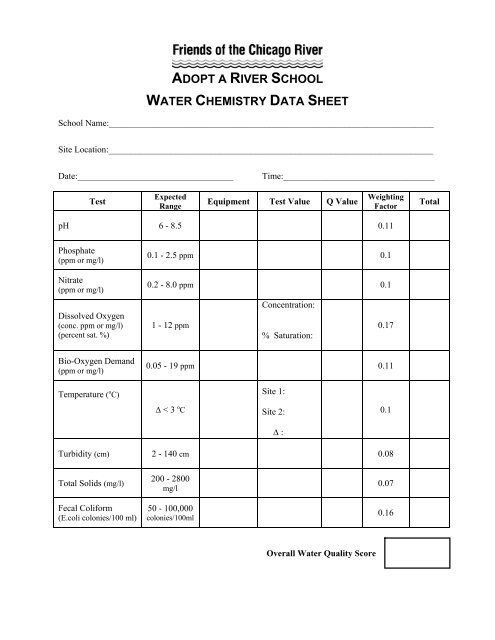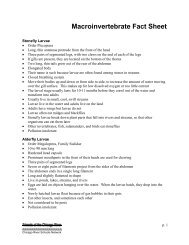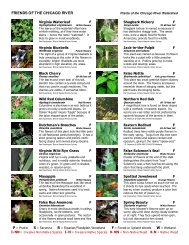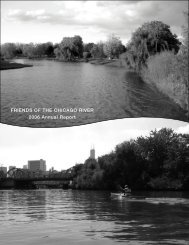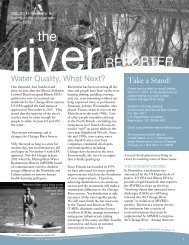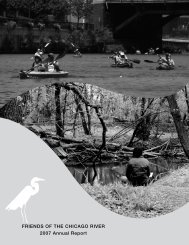Water Quality - Friends of the Chicago River
Water Quality - Friends of the Chicago River
Water Quality - Friends of the Chicago River
Create successful ePaper yourself
Turn your PDF publications into a flip-book with our unique Google optimized e-Paper software.
ADOPT A RIVER SCHOOL<br />
WATER CHEMISTRY DATA SHEET<br />
School Name:_________________________________________________________________________<br />
Site Location:_________________________________________________________________________<br />
Date:___________________________________ Time:__________________________________<br />
Test<br />
Expected<br />
Range<br />
pH 6 - 8.5<br />
Phosphate<br />
(ppm or mg/l)<br />
Nitrate<br />
(ppm or mg/l)<br />
Dissolved Oxygen<br />
(conc. ppm or mg/l)<br />
(percent sat. %)<br />
Bio-Oxygen Demand<br />
(ppm or mg/l)<br />
Temperature ( o C)<br />
0.1 - 2.5 ppm<br />
0.2 - 8.0 ppm<br />
1 - 12 ppm<br />
0.05 - 19 ppm<br />
∆ < 3 o C<br />
Turbidity (cm) 2 - 140 cm<br />
Total Solids (mg/l)<br />
Fecal Coliform<br />
(E.coli colonies/100 ml)<br />
200 - 2800<br />
mg/l<br />
50 - 100,000<br />
colonies/100ml<br />
Equipment Test Value Q Value Weighting<br />
Factor<br />
Concentration:<br />
% Saturation:<br />
Site 1:<br />
Site 2:<br />
∆ :<br />
Overall <strong>Water</strong> <strong>Quality</strong> Score<br />
0.11<br />
0.1<br />
0.1<br />
0.17<br />
0.11<br />
0.1<br />
0.08<br />
0.07<br />
0.16<br />
Total
ADOPT A RIVER SCHOOL<br />
MACROINVERTEBRATE DATA SHEET<br />
School Name:_________________________________________________________________________<br />
Site Location:_________________________________________________________________________<br />
Date:___________________________________ Time:__________________________________<br />
Macroinvertebrates<br />
(check all <strong>the</strong> ones you found)<br />
GROUP 1:<br />
Intolerant to pollution<br />
Alderfly<br />
Dobsonfly<br />
Snipe Fly<br />
Stonefly<br />
GROUP 2:<br />
Moderately intolerant<br />
to pollution<br />
Caddisfly<br />
Clam/Mussel<br />
Cranefly<br />
Crayfish<br />
Damselfly<br />
Dragonfly<br />
Mayfly<br />
Riffle Beetle<br />
<strong>Water</strong> Penny<br />
GROUP 3:<br />
Fairly tolerant to<br />
pollution<br />
Black Fly<br />
Midge<br />
Right-handed<br />
or o<strong>the</strong>r snails<br />
Scud<br />
Sowbug<br />
GROUP 4:<br />
Very tolerant to<br />
pollution<br />
Aquatic worm<br />
Blood worm<br />
Midge<br />
Leech<br />
Number <strong>of</strong><br />
TAXA<br />
(add up checks)<br />
Weighting Factor<br />
GROUP SCORE<br />
x 1 x 2 x 3 x 4<br />
(TAXA x<br />
weighting factor)<br />
= = = =<br />
TOTAL GROUP SCORE<br />
(add up <strong>the</strong> group scores from all <strong>the</strong> columns)<br />
TOTAL NUMBER OF TAXA<br />
(add up <strong>the</strong> number <strong>of</strong> taxa from all columns)<br />
WATER QUALITY INDEX<br />
(total group score ÷ total number <strong>of</strong> taxa)<br />
Left-handed snail<br />
<strong>Water</strong> <strong>Quality</strong> (circle one)<br />
Excellent 1.0 – 2.0<br />
Good 2.1 –2.5<br />
Fair 2.6 –3.5<br />
Poor greater than 3.6
Group 1 – These organisms are generally considered to be intolerant to pollution<br />
Alderfly Larva Dobsonfly Larva Snipe Fly Larva Stonefly Larva<br />
Group 2 – These organisms are generally considered to be moderately intolerant to pollution<br />
Freeswimming<br />
Caddisfly Larvae<br />
Case<br />
Maker<br />
Riffle Beetle Adult<br />
Clams Mussels<br />
Fingernail Asiatic Zebra Mussel <strong>Water</strong> Penny<br />
Damselfly Larvae Dragonfly Larvae<br />
Narrow-winged<br />
Broad-winged<br />
Skimmers Darner<br />
Larva Crayfish<br />
Cranefly Larva Mayfly Larvae<br />
Group 3 – These organisms are generally considered to be fairly tolerant to pollution<br />
Snails<br />
Black Fly Larva Midge Larva Right-Handed Orb Scud Sowbug<br />
(Gilled)<br />
Group 4 – These organisms are generally considered to be very tolerant to pollution<br />
Bloodworm<br />
Aquatic Worm Midge Larva Leech Left-Handed Snail<br />
O<strong>the</strong>r Aquatic Organisms<br />
Crawling Whirligig <strong>Water</strong> <strong>Water</strong> Scavenger Predacious<br />
<strong>Water</strong> Beetle Giant <strong>Water</strong> Bug Backswimmer Beetle <strong>Water</strong>boatman Strider Planaria Beetle <strong>Water</strong> Scorpion Diving Beetle
ADOPT A RIVER SCHOOL<br />
HABITAT ASSESSMENT DATA SHEET<br />
School Name:_________________________________________________________________________<br />
Site Location:_________________________________________________________________________<br />
Date:___________________________________ Time:__________________________________<br />
Present Wea<strong>the</strong>r:<br />
Clear/Sunny<br />
Overcast<br />
Wea<strong>the</strong>r in past 48 hours:<br />
Clear/Sunny<br />
Overcast<br />
<strong>Water</strong> Odor:<br />
None<br />
Sewage<br />
Chlorine<br />
<strong>Water</strong> Color:<br />
Clear<br />
Milky<br />
Foamy<br />
Physical Characteristics:<br />
Intermittent Showers<br />
Steady Rain<br />
Intermittent Showers<br />
Steady Rain<br />
Fishy<br />
Rotten Eggs<br />
Dark Brown<br />
Oily Sheen<br />
Heavy Rain or<br />
Thunderstorm<br />
Heavy Rain or<br />
Thunderstorm<br />
Petroleum<br />
O<strong>the</strong>r ______________<br />
Reddish<br />
Green<br />
Straight Meandering Braided Channelized Pool and riffle<br />
Canopy Cover:<br />
0% 1-5% 6-25% 26-50% 51-75% 76-100%
Available Stream Habitat:<br />
Check all that are present:<br />
Pools and riffles Wetland Rocks Log piles Weed beds<br />
Undercut banks Human made objects (pilings, concrete blocks, etc.)<br />
Bank and Riparian Vegetation:<br />
If more than one present, please record estimated percents:<br />
Barren _______ % Grasses _______ % Brush _______ %<br />
Deciduous trees _______ % Conifers _______ % O<strong>the</strong>r _______ %<br />
Bank Erosion:<br />
Estimate percent bare soil: ________ %<br />
Bank slope: Steep Moderate Slight<br />
Bank stability: Stable Slightly eroded Moderately eroded Severely eroded<br />
Human Use:<br />
Please check <strong>of</strong>f all that apply:<br />
Biking<br />
Hiking or nature walking<br />
Fishing<br />
Canoeing<br />
Partying<br />
Restoration site<br />
<strong>Water</strong>shed:<br />
Record a “D” next to dominant land uses and an “X” next to those land uses that are minor.<br />
Forest Park Scattered residential Sewage treatment<br />
Prairie or<br />
ungrazed fields<br />
Golf course<br />
Wetland Cropland<br />
Livestock<br />
pasture<br />
Moderate density<br />
residential<br />
High density<br />
residential<br />
Commercial<br />
Industrial<br />
Sanitary landfill
Site Map<br />
Draw a 100-foot long section <strong>of</strong> <strong>the</strong> river. Make sure to include: compass rose, key (if symbols are used), direction <strong>of</strong> river flow, location <strong>of</strong> pools<br />
& riffles, roads, bridges & paths, bank vegetation and areas <strong>of</strong> erosion. Also include information which identifies where you are along <strong>the</strong> river.


